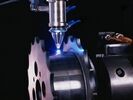The Process of Welding:
The Process of Laser Welding:
 The purpose of this article is to introduce readers to the process of laser welding.
The purpose of this article is to introduce readers to the process of laser welding.
Welding is defined as the physical act of connecting metals by forming atomic relations between them, using local or general heating, plastic transformation or the two actions at the same time. Another method for connecting metal parts is soldering, in which the metals are attached together by melting additional material.
There are 3 different classifications of welding:
thermal, thermo - mechanical and mechanical. Regardless of the classification, welding is achieved by the heating and changing of the materials being welded. Specific methods of welding include:
SMA - Shielded Metal Arc Welding – a manual arc welding process
TIG - Tungsten Inert Gas – an arc welding process that uses a tungsten electrode. The weld area is protected by ionized argon gas and a filler metal is normally used.
MIG - Metal Inert Gas - a welding process in which an electric arc forms between a consumable wire electrode and the work piece metal(s), which heats the work piece metal(s), causing them to melt, and join.
EBW - Electron Beam Welding - a fusion welding process in which a beam of high-velocity electrons is applied to two materials to be joined.
LBW - Laser Beam Welding - a welding technique used to join multiple pieces of metal through the use of a laser beam.
FW - Friction Stir Welding - a solid-state joining process (the metal is not melted) that uses a third body tool to join two surfaces.
Spot Welding – a process conducted by two electrodes for melting tin. Commonly used in the automotive industry.
Laser beam welding is achieved using two types of lasers:
Nd: Yag - mainly used for welding in low to medium power, producing parts for the electronics and healthcare industries, and more.
CO2 : mainly used for deep welds.
How does it work? As stated above, welding is achieved when materials are heated to fusion, which makes them combine. The laser ray produces light energy which is absorbed into materials and converted into heat energy. It is transferred via fiber optics or mirrors located in the ray conduction system of the welding machine. A lens is located in the head of the welding machine, concentrating the energy to a very small spot.
The laser emits coherent radiation; as a result, the dissipation of energy is minimal so it can travel great distances without significant loss of quality or energy. The laser ray is mostly used for welding raw materials and does not involve other materials in the welding process. It is highly efficient in processes requiring transfer of heat energy into smaller areas. The area affected by the heat energy is minimal (Heat Effected Zone). The finishing standard of laser welding is very high and requires no grinding and handling of welding, reducing products` manufacturing costs and the number of employees involved in manufacturing the product.
AMADA manufactures the worlds leading laser welding machines. For more information about our innovative technology –please contact your local ELBE representative.


